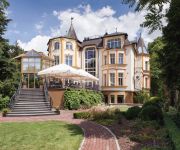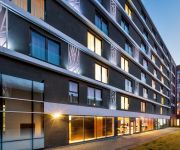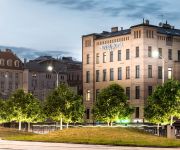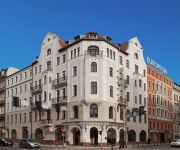Safety Score: 2,8 of 5.0 based on data from 9 authorites. Meaning we advice caution when travelling to Poland.
Travel warnings are updated daily. Source: Travel Warning Poland. Last Update: 2024-08-13 08:21:03
Discover Krzyki
The district Krzyki of Księże in Wrocław (Województwo Dolnośląskie) is a subburb in Poland about 186 mi south-west of Warsaw, the country's capital city.
If you need a hotel, we compiled a list of available hotels close to the map centre further down the page.
While being here, you might want to pay a visit to some of the following locations: Wroclaw, Siechnice, Zorawina, Dlugoleka and Czernica. To further explore this place, just scroll down and browse the available info.
Local weather forecast
Todays Local Weather Conditions & Forecast: 3°C / 37 °F
| Morning Temperature | 2°C / 35 °F |
| Evening Temperature | 1°C / 34 °F |
| Night Temperature | 0°C / 32 °F |
| Chance of rainfall | 0% |
| Air Humidity | 67% |
| Air Pressure | 1000 hPa |
| Wind Speed | Moderate breeze with 12 km/h (8 mph) from East |
| Cloud Conditions | Broken clouds, covering 79% of sky |
| General Conditions | Light rain |
Friday, 22nd of November 2024
2°C (36 °F)
-2°C (28 °F)
Snow, moderate breeze, broken clouds.
Saturday, 23rd of November 2024
3°C (37 °F)
-0°C (32 °F)
Light snow, fresh breeze, scattered clouds.
Sunday, 24th of November 2024
4°C (40 °F)
6°C (43 °F)
Moderate rain, moderate breeze, overcast clouds.
Hotels and Places to Stay
Radisson Blu Hotel
Hotel Grape
Invite
Jana Pawla II
Aparthotel Wierzbowa
Hotel Mercure Wroclaw Centrum
Hotel Sofia
Mojito Apartments
Europejski
Villa Rezydent
Videos from this area
These are videos related to the place based on their proximity to this place.
Nimbostratus'y nad wrocławskim osiedlem Księże Małe na dzielnicy Krzyki
Nimbostratus'y nad wrocławskim osiedlem Księże Małe na dzielnicy Krzyki. 12:39, 14.02.2014.
(HD) Linia Kolejowa D29-132 - przyjazd na stację Wrocław Główny po wakacjach
Filmowane z poc. IR WIELKOPOLANIN, IR-37127. Dnia 4.07.2010r.
EN57-2014 jako R 66329 (WR.GŁ.-MiĘDZYLESiE) przejazdem na Konduktorskiej
EN57-2014 jako R 66329 (WR.GŁ.-MiĘDZYLESiE) z SOKistami na pokładzie z przodu (którzy się na mnie patrzyli) przejeżdża 10 km/h na przejeździe z gongami od BOMBARDiER'a na ul.
2x Skoda 163 z R 66030 (6281 (PARDUB. HL.N.-WR.GŁ.)) na ul.Konduktorskiej
Dwie Skody 163 z R 66030 (6281 (Pardubice Hlavní Nádraží - Wrocław Główny)) przejeżdżają przez przejazd kolejowy na ul.Konduktorskiej. Od jakiegoś czasu pociągi w tym miejscu zwalniają...
EU07-197E jedzie w kierunku WR.GŁ. z wagonem pomiarowym iG WARSZAWA
EU07-197E w barwach PKP CARGO jedzie w kier. wrocławia GŁÓWNEGO od strony OPOLA GŁÓWNEGO z wagonem ig WARSZAWA o 14:17 w dniu 12.02.2014. Z pozdrowieniami dl...
E/C prawo jazdy we Wrocławiu na Man 12.240
http://www.badania-na-prawo-jazdy-wroclaw.com/Prawo jazdy kategorii E/C po pierwszych dwóch godzinach jazdy po mieście Wrocławiu. Muszę przyznać, że wrażenia są niesamowite, a taka...
Omówienie szkolenia z nauki jazdy po strefie egzaminacyjnej we Wrocławiu
Instruktor nauki jazdy omawia przebieg szkolenia z nauki jazdy motocyklem po mieście Wrocław w strefie egzaminacyjnej . Pokazane są zarówno błędy jak i pozytywne aspekty postępów kursanta.h...
Jazda autobusem od Word Wrocław na Ziębickiej poprzez Karwińską
Egzamin wewnętrzny przeprowadzany przez Krzysztofa Dąbrowskiego podczas szkolenia kursanta na prawo jazdy kategorii D. Jazda jest po jednej z tras egzaminacyjnych wybieranych przez ...
Wypadek tramwaju i TiR'a na ul.Krakowskiej we Wrocławiu (cz.13)
W dniu 08.01.2014 (Czwartek) miało miejsce zderzenia tramwaju (typ: Konstal 105 Na (http://pl.wikipedia.org/wiki/Konstal_105Na)) na linii 5, brygada 9, skład 2528+2527 (OPORÓW - KSiĘŻE...
Videos provided by Youtube are under the copyright of their owners.
Attractions and noteworthy things
Distances are based on the centre of the city/town and sightseeing location. This list contains brief abstracts about monuments, holiday activities, national parcs, museums, organisations and more from the area as well as interesting facts about the region itself. Where available, you'll find the corresponding homepage. Otherwise the related wikipedia article.
Wrocław University of Technology
Wrocław University of Technology (Polish: Politechnika Wrocławska, founded as German: Technische Hochschule Breslau) is an autonomous technical university in Wrocław, Poland. With buildings dispersed throughout the city, its main facilities are gathered at a central location near Plac Grunwaldzki, alongside the Oder River. It operates three regional branches in Jelenia Góra, Legnica, and Wałbrzych.
Racławice Panorama
The Racławice Panorama is a monumental (15 × 114 meter) cycloramic painting depicting the Battle of Racławice, during the Kościuszko Uprising. It is currently located in Wrocław, Poland. The painting is one of only a few preserved relics of a genre of 19th century mass culture, and the oldest in Poland. The panorama stands in a circular fashion and, with the viewer in the center, presents different scenes at various viewing angles.
Plac Grunwaldzki
Plac Grunwaldzki (Grunwald Square, named for the Battle of Grunwald) is a large square and important transit point in Wrocław, Poland. The nearby Wrocław University of Technology and dormitories also make it one of the centers of student life in Wrocław.
Centennial Hall
The Centennial Hall is a historic building in Wrocław, Poland. It was constructed according to the plans of architect Max Berg in 1911–1913, when the city was part of the German Empire. As an early landmark of reinforced concrete architecture, it was listed as a UNESCO World Heritage Site in 2006. The building is frequently visited by tourists and the local populace.
Tumski Bridge
Tumski Bridge is a steel bridge over the north branch of the Oder river in Wrocław, Poland. Constructed in 1889 it replaced an old wooden bridge to connect Ostrów Tumski and Wyspa Piaskowa. Until 1945, its name was Dombrücke. It is an old road bridge now open to pedestrians only. Tumski Bridge is also called Lovers Bridge, Cathedral Bridge or Green Bridge. It's a place of enamoured tradition for lovers. The bridge is full of padlocks which lovers leave to cherish their feelings.
Wrocław Cathedral
The Cathedral of St. John the Baptist in Wrocław, (Polish: Archikatedra św. Jana Chrzciciela, German: Breslauer Dom, Kathedrale St. Johannes des Täufers), is the seat of the Roman Catholic Archdiocese of Wrocław and a landmark of the city of Wrocław in Poland. The cathedral, located in the Ostrów Tumski district, is a Gothic church with Neo-Gothic additions. The current standing cathedral is the fourth church to have been built on the site.
Szczytnicki Park
Szczytnicki Park in Wrocław, Poland is located to the east of Plac Grunwaldzki and the old Oder river, and covers approximately 1 square kilometre of land. The park, besides offering many sightseeing attractions, also has many dendrological rarities. The land under the park was first mentioned in writing in 1204, when Henryk I the Bearded donated the village Stitnic to the monastery of St. Vincent, where shields were produced for the duke's forces.
Wroclaw University of Environmental and Life Sciences
The Wroclaw University of Environmental and Life Sciences is a university in Wrocław, Poland. Its heritage is deeply rooted in the traditions of two institutions founded in Lviv: the Faculty of Agriculture and Forestry of Lviv Polytechnic in Dublany and the Veterinary School of Medicine, founded in 1881.
Iglica
Iglica (Polish; "the spire" or "needle") is a needle-like monument in Wrocław, Poland. It was built in 1948 and was 106 metres tall. Today, after renovation, the top ten metres have been removed and it is now 96 metres tall. This structure was constructed by Polish Communists for an exhibition to celebrate the regaining control over the "Regained Territories" after Second World War. The Iglica is located very close to the Centennial Hall.
Olympic Stadium (Wrocław)
Olympic Stadium in Wrocław (Polish: Stadion Olimpijski we Wrocławiu, German: Schlesierkampfbahn im Sportpark Leerbeutel, Olympiastadion, Hermann Göring Stadion) is a multi-purpose stadium in Wrocław, Poland. It is currently used mostly for speedway racing. It serves as the home stadium of Sparta Wrocław. The stadium has a capacity now of 35,000 people and was opened in 1928 as the Silesian Arena (Schlesierkampfbahn), when Wrocław was still part of Germany as Breslau.
Iwiny, Wrocław County
Iwiny is a village in the administrative district of Gmina Siechnice, within Wrocław County, Lower Silesian Voivodeship, in south-western Poland. Prior to 1945 it was in Germany. It lies approximately 4 kilometres west of Święta Katarzyna, and 10 kilometres south of the regional capital Wrocław. The village has a population of 330.
Radwanice, Wrocław County
Radwanice is a village in the administrative district of Gmina Siechnice, within Wrocław County, Lower Silesian Voivodeship, in south-western Poland. Prior to 1945 it was in Germany. It lies approximately 3 kilometres north of Święta Katarzyna and 9 km south-east of the regional capital Wrocław. The village has a population of 2,328.
Wrocław Główny railway station
Wrocław Main Station is the biggest and most important passenger rail station of the southwestern Polish city of Wrocław. Built in the mid-19th century near the center of the city, until 1945 it was known as Breslau Hauptbahnhof. It also is the biggest rail station of Lower Silesia, located at the junction of several important routes.
Wrocław Fountain
The Wrocław Fountain — Wrocław Multimedia Fountain, — Polish: Wrocławska Fontanna, is a multimedia musical fountain and ornamental pond in Wrocław, of western Poland.
Zoological Garden in Wrocław
The Wrocław Zoological Garden, known simply as the Wrocław Zoo (Polish: Ogród Zoologiczny we Wrocławiu, German: Zoologischer Garten Breslau) is a scientific zoo on Wróblewskiego Street in Wrocław, Poland. It is the oldest zoo in Poland, having been founded in 1865 as the Breslau Zoological Garden while the city was part of Prussia. It is also the largest (in terms of the number of animals) zoo in Poland. The zoo covers about 30 hectares in downtown Wrocław.
Museum of Architecture, Wrocław
The Museum of Architecture is in Wrocław, Poland. The museum is the only architecture museum in Poland. It is located in a 15th century post-Bernardine set of buildings, including the St Bernardine of Sienna Church and a monastic quadrangle with a garden. The Museum of Architecture was a founder-member of the International Federation of Architectural Museums (ICAM).
Zwierzyniecki Bridge
Zwierzyniecki Bridge is located in the eastern part of the Wrocław, Poland. The bridge spans the Oder River and is in the immediate vicinity of Wrocław Zoo and the exhibition grounds about Centennial Hall. The bridge was built around 1655 and was originally wooden. Between 1895 and 1897, Karl Klimm designed a new bridge under the supervision of the city architect, Richard Plüddemann and with the help of engineer A. Fruhwirth.
Wrocław Market Hall
Wrocław Market Hall was designed by Richard Plüddemann and built between 1906-08. It is situated by Ulica Piaskowa, at the junction of Plac Nankiera and Ulica Sw. Ducha close to Market Square, Wrocław and oldest districts of Wrocław. The Hall was completed along with similar building at Ulica Kolejowa. Both buildings were created in order to organize street trading in the city center. Once completed, all street markets have been moved into the newly opened halls.
Peace Bridge Wrocław
The bridge in its current state was constructed over the period of 1954–1959. It spans over 124 metres and was designed by professor Jan Kmita. At first it was known as Wojewodzki Bridge and renamed to Peace Bridge in 1966. Also before the war there was a bridge in the same place renamed after German philosopher, poet and literate Gotthold Ephraim Lessing (Lessingbrucke). Made of iron, originally built in 1875, it lasted until 1945 when it was bombarded during the Festung Breslau siege.
Wrocław exhibition ground
Wrocław Exhibition Grounds are located in eastern part of the city close to the zoological garden. Construction works took place in years 1911-1913 according to the project of Max Berg and Hans Poelzig.
Oławski Bridge
Oławski Bridge is a road bridge over the Oława River in Wrocław, Poland. It was also known as Mauritius Brücke (German) or St. Mauritius Bridge (English), Margarethenbrücke, and Most Wygonowy (cattle drive bridge). It was constructed during 1882-1883 and was designed by Alexander Kaumann, with assistance from Eger and Reichelt, Beer, Wackwitz and Hoffmann.
Grunwaldzki Bridge
Grunwaldzki Bridge is a suspension bridge over the Oder River in Wrocław, Poland, built over the years 1908-1910. Initially the bridge was called the Imperial (Kaiserbrücke), then the bridge of Freedom (Freiheitsbrücke). Architectural designer of the bridge was a city councilor Richard Plüddemann. The bridge opened on 10 October 1910 in the presence of Emperor Wilhelm II.
WUWA (Wroclaw)
WUWA (germ. Wohnungs-und Werkraumausstellung, Workplace and House Exhibition) was a building exhibition held in Wroclaw in 1929. Organized by the Silesian committee of the Deutsche Werkbund, close to the Szczytnicki park (currently Tramwajowa, Dembowskiego, Mikolaja Kopernika and Zielonego Dębu streets). Several local architects, mainly members of Werkbund, participated in the exhibition. 37 different types of buildings were presented to serve as "standards".
Eugeniusz Geppert Academy of Fine Arts
The Eugeniusz Geppert Academy of Fine Arts in Wrocław (Polish: Akademia Sztuk Pięknych im. Eugeniusza Gepperta we Wrocławiu) is a public institution of higher learning established in 1946 originally as the College of Fine Arts. From 2008 the university bears the name of Polish master-painter Eugeniusz Geppert.
National Museum, Wrocław
The National Museum in Wrocław (Polish: Muzeum Narodowe we Wrocławiu), established in 1947, is one of Poland's main branches of the National Museum system. It holds one of the largest collections of contemporary art in the country. The holdings of Wrocław Museum are closely connected with the history of border shifts in Central Europe following World War II.
























